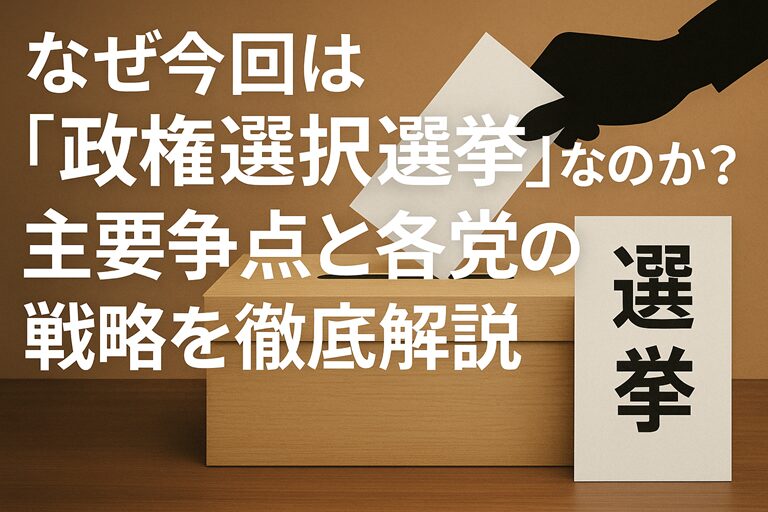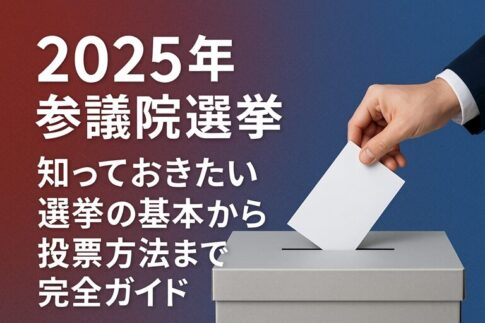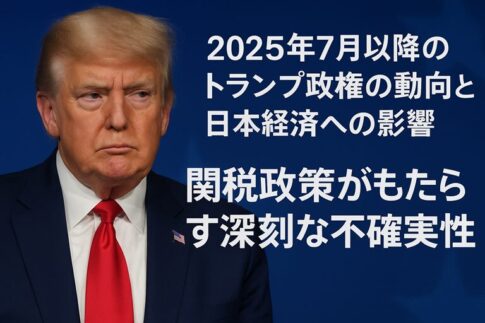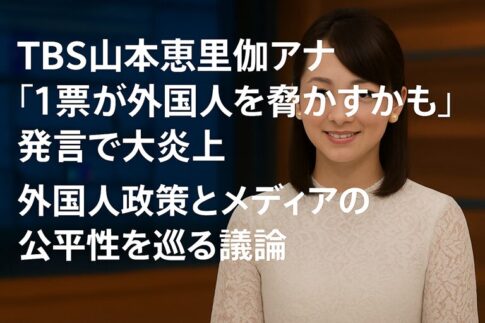目次
- 1 Japan 2025 Election: Ruling Coalition at Risk – Why This Upper House Vote Is a De Facto Regime Change Election
- 1.1 1. The Ruling Coalition’s Crisis: The Specter of a “Capsized Diet”
- 1.2 2. The Central Issue: Inflation Response – “Cash Handouts vs. Tax Cuts” Debate
- 1.3 3. Political Funding Scandals: The Slush Fund Crisis and Structural Issues
- 1.4 4. Population Decline and Social Security: Intergenerational Conflict or Solidarity?
- 1.5 5. Foreign Policy and Security: Responding to the Trump Administration’s Return
- 1.6 6. Opposition Strategy: “Hop, Step, Jump” Toward Regime Change
- 1.7 7. Rise of New Parties: The Sanseito Phenomenon and SNS Election Impact
- 1.8 8. Voter Turnout Trajectory: Impact of the Three-Day Weekend
- 1.9 9. Grand Coalition Possibility: Realistic Scenario or Fantasy?
- 1.10 10. Tokyo Assembly Election Results: A Harbinger
- 1.11 Conclusion: The 2025 Upper House Election as a Historical Turning Point
Japan 2025 Election: Ruling Coalition at Risk – Why This Upper House Vote Is a De Facto Regime Change Election
As Japan’s 2025 House of Councillors (Upper House) election approaches, political analysts and party leaders are unanimous: this is not merely a midterm test. This election is being positioned as a “de facto regime change election,” with results that could decisively shape Japan’s political trajectory for years to come.
The stakes have been dramatically raised because the ruling Liberal Democratic Party (LDP) and Komeito coalition lost their majority in the previous Lower House election, becoming a “minority government.” If they fail to secure a majority in this Upper House election as well, Japan will face an unprecedented “capsized Diet” situation where the ruling parties lack control in both chambers.
Related Articles
1. The Ruling Coalition’s Crisis: The Specter of a “Capsized Diet”
The LDP-Komeito coalition has set a remarkably low target of securing just 50 seats to maintain their majority when combined with 75 uncontested seats. This modest goal reflects deep anxiety within the ruling parties about their electoral prospects.
If the ruling coalition falls below 50 seats, they will lose their majority in both houses of the Diet—an unprecedented “capsized Diet” situation. This would lead to:
• Extremely unstable governance requiring opposition cooperation for every bill
• The need to expand the coalition beyond LDP-Komeito or face regime change
• Possible snap elections for both houses simultaneously
Prime Minister Ishiba’s “Minority Government Paradox”
The Ishiba administration currently operates under what’s called the “minority government paradox.” While the ruling parties need opposition cooperation to pass legislation, this delicate balance has prevented internal LDP challenges to Ishiba’s leadership due to:
- Risk of opposition parties uniting behind an alternative candidate in a prime ministerial election
- Fear that internal divisions would lead to further electoral losses
- Complete governmental paralysis if cooperation with opposition parties breaks down
However, depending on the Upper House election results, moves to oust Ishiba could gain momentum. LDP heavyweights including Taro Aso, Fumio Kishida, and Toshimitsu Motegi are reportedly discussing post-election governance scenarios behind the scenes.
Ishiba’s 40-Year Parliamentary Experience and Current Recognition
Prime Minister Ishiba, marking his 40th year as a Diet member, acknowledges that “both political parties and public needs have become far more diverse than when I started.” Amid this diversifying political landscape, securing seats has become the paramount challenge.
He has been emphasizing Japan’s international role through events like the Osaka Expo and G7 meetings, attempting to translate diplomatic achievements into domestic political support.
2. The Central Issue: Inflation Response – “Cash Handouts vs. Tax Cuts” Debate
The most prominent election issue is how to address worsening inflation. The ruling and opposition parties propose fundamentally different approaches, reflecting not just policy differences but contrasting economic philosophies.
Ruling Coalition (LDP-Komeito) Approach: Targeted Support Through Cash Handouts
- 20,000 yen universal cash handout (additional 20,000 yen for low-income households, totaling 40,000 yen)
- Cautious stance on consumption tax cuts – concerns about social security funding
- Advantages of cash handouts: Speed, targeted support for those in need, low administrative costs
- Release of government rice reserves to suppress rice prices
- Continuation of gasoline price subsidies
Komeito offers a unique perspective, advocating that “both tax cuts and handouts should be utilized to overcome inflation.” They note that while the reduced 8% tax rate on food items is structurally important for supporting social security, they believe 5% would be more appropriate in the future. However, they argue that temporary rate adjustments contradict the spirit of integrated social security and tax reform.
Opposition Approaches: Fundamental Relief Through Tax Cuts
Opposition parties strongly advocate for tax cuts, though their proposals vary significantly in scope and funding mechanisms.
Constitutional Democratic Party (CDP): Temporary Zero Tax on Food
- Temporary 0% consumption tax on food items (1 year)
- Funding sources (approximately 10 trillion yen total):
- Reallocation of fund reserves: 4.6 trillion yen
- Foreign exchange fund surplus: 3.6 trillion yen
- Review of special tax measures (hidden subsidies, wage increase tax incentives): 1.8 trillion yen
- Highlighting success in passing “Gasoline Tax Suspension Bill” in Lower House
- Aiming for realization by gaining more Upper House seats
Japan Innovation Party (Ishin): Social Insurance Reform Combined with Food Tax Cuts
- Social insurance premium reduction as top priority
- 0% consumption tax on food for 2 years
- Funding through healthcare spending cuts:
- Hospital bed reduction for efficiency
- Increased co-payments for elderly (means-tested)
- “No need to cut taxes on luxury goods purchases by the wealthy” – pragmatic approach
- Focus on essential food items only
Democratic Party for the People (DPP): Major Tax Rate Reduction with Conditions
- Reduce consumption tax from 10% to 5%
- Return to 10% when real wage growth reaches +2%
- Income tax cuts also implemented
- Energy policy:
- Abolish temporary gasoline tax
- Restart nuclear plants for affordable, stable electricity
- Priority on achieving “an economy where salaries rise”
Japanese Communist Party (JCP): Phased Tax Elimination with Corporate Tax Reform
- Reduce consumption tax to 5%, ultimately aim for 0%
- Funding through increased corporate and wealth taxes:
- Raise corporate tax rates
- Eliminate preferential tax treatment for large corporations
- Strengthen financial income taxation
- No cuts to social security spending, rather expansion
- “Consumption tax is regressive, a tax that bullies ordinary people”
Sanseito and Reiwa Shinsengumi: Permanent Tax Abolition
- Phased or permanent abolition of consumption tax (0%)
- Reiwa’s funding theory:
- Strengthen progressive corporate and income taxes
- Fiscal stimulus through government bonds (based on MMT)
- Sanseito: Achieve domestic demand expansion and economic growth through tax abolition
- Both parties agree: “Consumption tax is a bad tax that should be abolished”
3. Political Funding Scandals: The Slush Fund Crisis and Structural Issues
The LDP’s historic defeat in the previous Lower House election was primarily attributed to the party ticket income non-disclosure scandal, known as the “slush fund problem.” Despite the introduction of public party funding, the practice of accepting corporate donations—”double-dipping”—and the existence of unaccounted funds have generated strong public distrust.
Prime Minister Ishiba’s “Strict Response” Contradictions
Prime Minister Ishiba initially promised strict measures against the slush fund problem, demonstrating resolve by denying official endorsement to implicated legislators. However, reports late in the campaign revealed that the party headquarters provided 20 million yen in financial support to these non-endorsed candidates, triggering criticism of “ultimately being lenient with insiders.”
Each Party’s Specific Political Finance Reform Proposals
LDP: Trust Recovery Through Enhanced Transparency
- Not banning corporate donations but maximizing transparency through disclosure
- Building systems for easy public access to political funding reports through digitalization
- Strengthening audit functions and regular checks by third-party organizations
- Tougher penalties for violators (extending periods of civil rights suspension)
CDP: Complete Ban on Corporate Donations
- Legislate complete prohibition of corporate and organizational donations
- In principle, prohibit corporate purchases of party tickets
- Promote individual donations (expand tax benefits)
- Disclose all political funding usage from 1 yen
Ishin: Practicing “Self-Sacrifice Reform”
- Party has already banned corporate donations (emphasizing track record)
- Implemented 20% reduction in lawmakers’ salaries
- Partial return of public party funding
- However, criticized for supporting 10-year delay in disclosing policy activity expenses in political funding law revision
JCP: “Akahata” Achievements and Consistent Stance
- “Akahata” newspaper broke the LDP slush fund scandal
- Advocating corporate donation bans for over 50 years
- Also refuses public party funding (“violates freedom of thought and conscience”)
- Party operations funded only by individual donations and newspaper revenue
4. Population Decline and Social Security: Intergenerational Conflict or Solidarity?
With Japan’s births expected to fall below 700,000 annually and population decline accelerating, the sustainability of healthcare, nursing care, and pension systems has become an urgent issue. Each party’s response reflects their underlying political philosophy.
Fierce Debate Over Intergenerational Burden Redistribution
Ishin: The Necessity of Painful Reform
“Increased burden on the elderly is unavoidable. By redirecting saved resources to investment in children, we can achieve a sustainable society. We cannot close our eyes to difficulties.”
Specific Measures:
• Increase medical co-payments from 10-30% to 20-40% based on income
• Gradually raise pension eligibility age (ultimately to 70)
• Review nursing care insurance self-payment ratios
• Redirect savings to free education and child support
JCP: Social Security Should Not Be Cut
“Cutting social security creates people who cannot receive treatment. Sufficient funding can be secured by eliminating preferential treatment for large corporations.”
Specific Measures:
• Unify medical costs for those 75+ at 10% co-payment
• Raise minimum pension guarantee to 100,000 yen monthly
• Increase nursing care worker wages by 100,000 yen monthly
• Fund through increased taxation on corporations and wealthy individuals
Each Party’s Approach to Declining Birthrate: Different Strategies
LDP: Comprehensive Environmental Improvement
- Improve nursing, medical, and care workplace environments to support women’s employment
- Promote marriage and childbirth through increased labor share and income growth
- Create environments for safe child-rearing through disaster prevention investments
- Strengthen support for three-generation households living together or nearby
CDP: Support Enhancement Through System Reform
- Review childcare worker placement standards (0-year-olds from 3:1 to 2:1)
- Extend child allowances to age 18 and remove income restrictions
- Complete free education (from early childhood to university)
- Target 80% male parental leave usage through corporate mandates
Komeito: Societal Consciousness Reform
- Prioritize “recovering society-wide consciousness of supporting child-rearing”
- Create attractive industries and employment in regions to prevent urban population drain
- Establish government funds with pension management track records, allocate returns to child support
- Economic incentives for grandparent support in child-rearing
DPP: Solution Through Economic Growth
- Policy based on analysis showing “strong correlation between marriage numbers and birth numbers”
- Recognition that rising real wages promote marriage and childbirth
- Top priority on achieving “an economy where salaries rise”
- Create 10 million yen birth celebration fund for third and subsequent children
5. Foreign Policy and Security: Responding to the Trump Administration’s Return
With the Trump administration’s return, Japan’s foreign and security policies face a major turning point. The trajectory of automobile tariff negotiations could impact Japan’s entire economy, making each party’s response closely watched.
Each Party’s Strategy for Trump Tariffs
LDP: Balancing the US-Japan Alliance with National Interests
- Reaffirm importance of US-Japan security arrangements and enhance effectiveness
- Recognize auto tariff negotiations are in “difficult situation” while conducting negotiations that don’t harm national interests
- Emphasize G7 unity, fulfill responsibilities as Asia’s sole participant
- Respond firmly to Trump’s Hiroshima-Nagasaki comments with “never again” message
- Accelerate achieving 2% of GDP defense spending target
CDP: Establishing Independent Diplomacy
- Renew pledge to abolish “unconstitutional portions” of peace and security legislation
- Demand revision of US-Japan Status of Forces Agreement (“say what needs to be said” diplomacy)
- Criticize Japan being “pushed around too much” by Trump’s tariff policies
- Promote multilateral trade negotiations as free trade champion
- Achieve observer participation in Treaty on the Prohibition of Nuclear Weapons conference
Komeito: Unique Approach to Nuclear Abolition
- Promote nuclear abolition efforts while acknowledging reality of nuclear umbrella
- Only ruling party advocating observer participation in nuclear ban treaty conference
- Actually dispatched lawmakers to participate in international discussions
- Emphasize moral responsibility as “only atomic-bombed nation”
6. Opposition Strategy: “Hop, Step, Jump” Toward Regime Change
CDP leader Yoshihiko Noda has articulated a long-term strategy for regime change. This “Hop, Step, Jump” strategy is not mere sloganeering but presents a concrete roadmap.
Hop (Achieved): Force ruling coalition into minority in previous Lower House election
Step (Current): Further pressure ruling parties in Upper House election, achieve “capsized Diet”
Jump (Next): Achieve regime change in next Lower House election
Opposition Cooperation in Single-Member Districts: Key to Success
In the 32 single-member districts (out of 45 total constituencies), unifying opposition candidates is crucial for victory. However, this coordination faces significant challenges:
- Difficulty gaining understanding from each party’s support base
- Individual candidate pride and regional circumstances
- How to overcome policy differences
- How to guarantee post-election cooperation
Track Record of “Casting Vote” Strategy
With the ruling coalition lacking a Lower House majority, the DPP and Ishin increasingly hold the “casting vote.” Actual achievements include:
- Free high school tuition: Realized through cooperation with Ishin
- Pension system reform law: Passed with CDP cooperation
- Gasoline tax suspension bill: Passed Lower House through joint opposition effort (rejected in Upper House)
Based on these achievements, opposition parties appeal that “gaining more Upper House seats will enable more policy implementation.”
7. Rise of New Parties: The Sanseito Phenomenon and SNS Election Impact
New parties like Sanseito are attracting particular attention in this Upper House election. Analysis suggests that some traditional LDP supporters, particularly conservatives dissatisfied with the Ishiba administration, are shifting their support to these parties.
Sanseito’s Characteristics and Support Expansion Background
- Conservative message of “protecting Japan’s traditions and culture”
- Constitutional amendment proposal includes phrases like “The Emperor is sacred and inviolable”
- Prioritize education investment, emphasizing individual capability enhancement
- Actively utilize YouTube and SNS, bypassing traditional media
- “Grassroots strategy” steadily securing local assembly seats
Sanseito’s constitutional amendment proposals have drawn criticism as “prewar revisionist,” but supporters praise them as “restoring Japanese pride.” Since parties can win proportional representation seats with just 2% of the national vote, the Upper House election presents an important opportunity for new parties to enter national politics.
The Double-Edged Sword of SNS Elections
While all parties are advancing SNS utilization, its impact has both positive and negative aspects:
Positive Aspects
- Reaching demographics previously uninterested in politics through traditional media
- Direct communication between candidates and voters
- Real-time policy announcements and feedback
- Reduced campaign costs
Negative Aspects
- Spread of misinformation and misunderstandings through edited clips
- Deepening divisions through echo chamber effects
- Emotional reactions hindering constructive discussion
- Potential for information manipulation by foreign actors
8. Voter Turnout Trajectory: Impact of the Three-Day Weekend
With voting day falling in the middle of a three-day weekend, concerns about voter turnout impact are rising. Based on historical data, the following trends are anticipated:
| Turnout Scenario | Expected Turnout | Parties Benefiting | Reason |
|---|---|---|---|
| Low Turnout | Under 45% | LDP, Komeito, JCP | Increased weight of organized votes |
| Medium Turnout | 45-55% | CDP, Ishin | Some movement of swing voters |
| High Turnout | Over 55% | New parties, Independents | Large movement of floating votes |
9. Grand Coalition Possibility: Realistic Scenario or Fantasy?
Some political analysts are discussing the possibility of a grand coalition in case of “national crisis.” Potential “national crisis” scenarios include:
- Major disasters (Nankai Trough earthquake, Tokyo metropolitan earthquake, etc.)
- Economic crisis from escalating Trump tariff issues
- Rapid deterioration of East Asian situation
- New infectious disease pandemic
While there have been precedents like the Murayama Cabinet (LDP-Socialist-Sakigake coalition), observers note there are virtually no “underground channels” between the current LDP and CDP that would enable such cooperation. Differences in security policy and constitutional views, in particular, cannot be easily bridged.
10. Tokyo Assembly Election Results: A Harbinger
The LDP’s major defeat in the recent Tokyo Metropolitan Assembly election is being watched as a precursor to the Upper House election. Within the LDP, the following analysis is being conducted:
- Tokyo residents’ anger over the slush fund problem remains unabated
- Deep-rooted dissatisfaction with inflation responses
- Impact of declining support for Prime Minister Ishiba
- Confrontation with Governor Koike backfiring
These results have heightened the sense of crisis within the LDP, leading to rapid revisions of election tactics.
Conclusion: The 2025 Upper House Election as a Historical Turning Point
The 2025 House of Councillors election has the potential to become a significant turning point in Japan’s political history, going beyond mere seat gains and losses. Key points to watch include:
- Whether the ruling coalition maintains its majority: A “capsized Diet” would rapidly destabilize politics
- Direction of inflation measures: Citizens choose between cash handouts or tax cuts
- Political funding issues: Can the LDP regain trust?
- Trajectory of intergenerational conflict: Can pain be shared in social security reform?
- New party breakthroughs: Will they become receptacles for dissatisfaction with existing parties?
This election’s results will significantly impact not only the possibility of regime change in the next Lower House election but potentially the very nature of Japanese democracy itself. Each voter’s choice carries more weight than ever before.















Leave a Reply